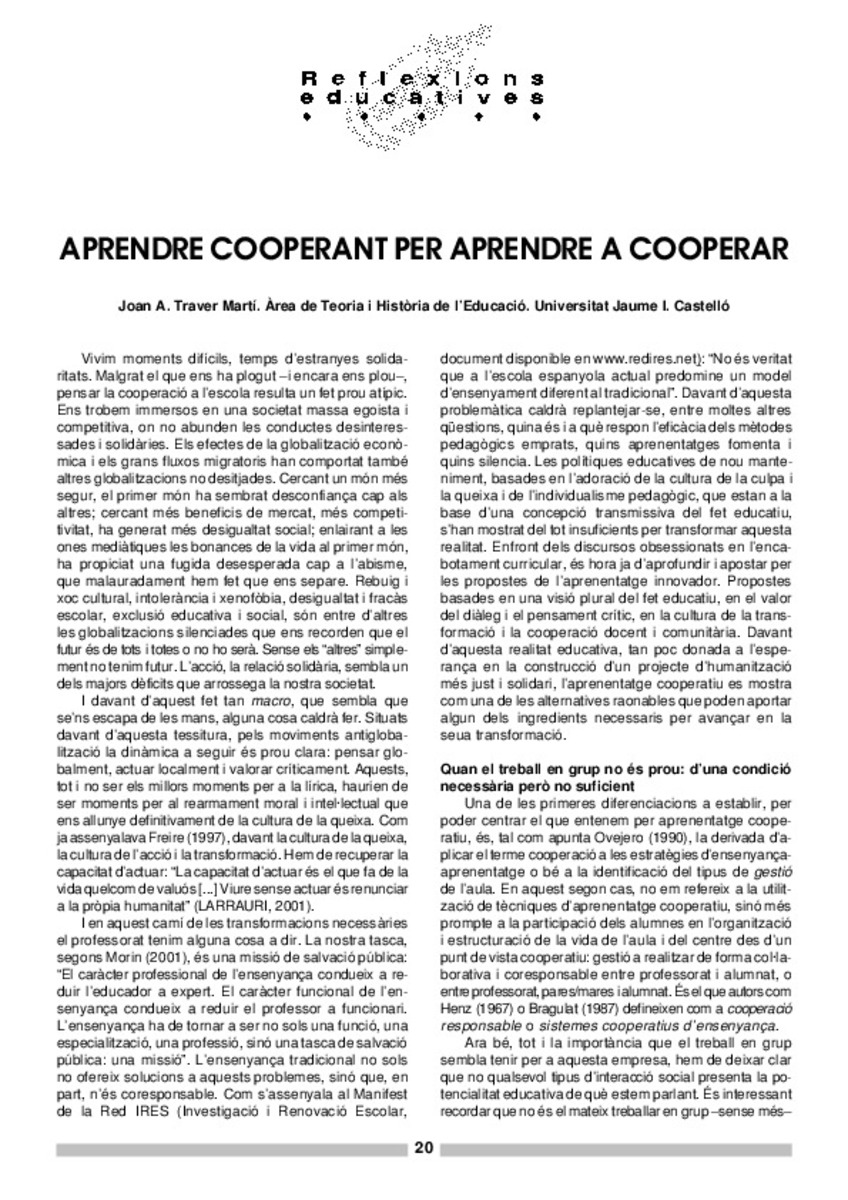Mostrar el registro sencillo del ítem
Aprendre cooperant per aprendre a cooperar
| dc.contributor.author | Traver-Martí, Joan Andrés | |
| dc.date.accessioned | 2012-05-28T11:29:57Z | |
| dc.date.available | 2012-05-28T11:29:57Z | |
| dc.date.issued | 2009 | |
| dc.identifier.citation | Comunicació educativa (2011), no. 22, 20-25 | ca_CA |
| dc.identifier.issn | 1575-9911 | |
| dc.identifier.uri | http://hdl.handle.net/10234/38884 | |
| dc.description.abstract | L’aprenentatge cooperatiu és primàriament un canvi en l’estructura de la meta, fomentant la interdependència dels objectius entre els membres del grup, però també implica canvis en els altres elements que componen l’estructura d’aprenentatge. En una organització de l’aprenentatge de forma cooperativa cada alumne o alumna participant sap que el seu èxit personal ajuda els seus companys i companyes a aconseguir el seu. Els resultats que persegueix cada membre del grup són beneficiosos per a tots. Entenent sistèmicament les relacions entre aquests tres tipus d’estructures, podem aventurar que els canvis produïts en l’estructura de la meta també produiran canvis en les altres dos estructures. L’estructura de l’activitat ha d’evolucionar des d’una organització de l’activitat primàriament individual fins a una altra estructura caracteritzada per la interacció dels alumnes en xicotets grups, que en conseqüència hauran de gaudir de més autonomia decisòria respecte al seu treball i afectaran, per tant, l’estructura de l’autoritat. | ca_CA |
| dc.description.abstract | Cooperative learning is primarily a change in the goal structure by fostering the interdependence of objectives among the members of the group. Yet it also involves changes in the other elements that make up the learning structure. In a cooperation-based learning arrangement, each participating student knows that their own personal success also helps each of their companions to achieve theirs. The outcomes pursued by each member of the group are beneficial for everyone. With a systematic understanding of the relationships among these three types of structures, we can say that the changes produced in the goal structure will also bring about changes in the other two structures. The structure of the activity must evolve from an activity arrangement that is primarily individual towards another structure that is characterised by the interaction of students in small groups. These groups will need to enjoy greater autonomy as regards making decisions about their work and will, therefore, affect the authority structure. | |
| dc.format.extent | 6 p. | ca_CA |
| dc.format.mimetype | application/pdf | ca_CA |
| dc.language.iso | cat | ca_CA |
| dc.publisher | Àrees de Didàctiques Específiques de la Universitat Rovira i Virgil | ca_CA |
| dc.rights | © Àrees de Didàctiques Específiques de la Universitat Rovira i Virgil | ca_CA |
| dc.rights.uri | http://rightsstatements.org/vocab/InC/1.0/ | * |
| dc.subject | Aprenentatge cooperatiu | ca_CA |
| dc.subject | Interacció dels alumnes | ca_CA |
| dc.subject | Cooperar en l’aula | ca_CA |
| dc.subject | Treball en grup | ca_CA |
| dc.subject | Cooperative learning | |
| dc.subject | Student interaction | |
| dc.subject | Cooperate in the classroom | |
| dc.subject | Group work | |
| dc.subject.lcsh | Inclusive education | ca_CA |
| dc.subject.other | Educació inclusiva | ca_CA |
| dc.title | Aprendre cooperant per aprendre a cooperar | ca_CA |
| dc.type | info:eu-repo/semantics/article | ca_CA |
| dc.rights.accessRights | info:eu-repo/semantics/openAccess | ca_CA |
| dc.relation.publisherVersion | http://www.fcep.urv.cat/comeduc/marcs.html | ca_CA |
Ficheros en el ítem
Este ítem aparece en la(s) siguiente(s) colección(ones)
-
EDU_Articles [504]







